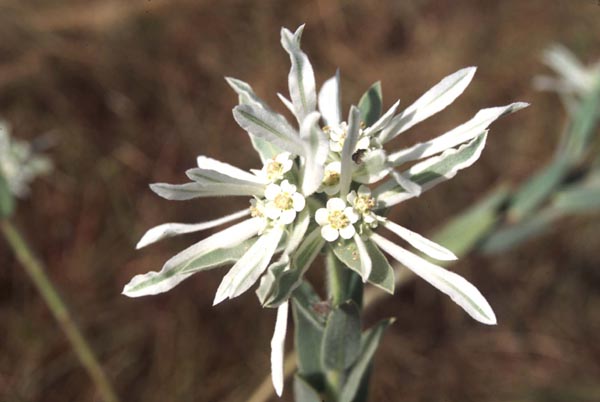
SotP is a native plant in north Texas prairies and pastures. It flowers in late summer and early fall; the flowers are small and pale but are "subtended" by showy "bracts" (to use botanical terminology). Bracts are leaves that are modified to attract insect pollinators to flowers when the flowers themselves are not showy. Both the flowers and bracts of SotP are white, giving this plant its common name. Pastures where this plant is common almost do look snow-covered.
An aside: What is the distinction between "prairies" and "pastures"? For me, a prairie is a patch of grassland that was historically, and still is because it has been preserved, covered with the vegetation that was there before the arrival of Europeans in North America. This vegetation is very different from the vegetation that encroaches when prairies are plowed for agriculture or are heavily grazed by cattle, which are an exotic species. The exact species of plants that constitute the prairie community vary from place to place within the Great Plains, from "tallgrasses" in the moist eastern parts, through "midgrasses" in the middle part, to "shortgrasses" in the dry west. The other herbaceous (not woody) plants, known collectively as "forbs" (these would mostly be the wildflowers), also change as one travels across the plains. So a prairie is a community of native plants that would have occurred naturally in the Great Plains before that region was transformed by humans, and prairies are now found only where the vegetation has not been transformed. A pasture, on the other hand, is usually (although not always) a patch of grassland that no longer supports the native grasses and forbs, but instead is covered to a greater or lesser extent by non-native plants (or by native plants that are not common in prairies). Many exotic grasses have been introduced into North America because they were thought to be better forage for cattle than the native plants (e.g. Johnson grass, King Ranch bluestem). As a result of both plowing the prairie for agriculture and introduction of exotic plants (and suppressing naturally occurring grassfires, but that is another story), practically all of the North American prairies are gone, and what is left is croplands and pastures for cattle. But enough of that soapbox for now.
Although SotP is a native plant, it is also an "increaser" in disturbed or overgrazed prairies and pastures. Because it is unpalatable to cattle, SotP increases in density when other plants are grazed. It produces relatively large numbers of large seeds, and these disperse easily because the seed pods are "ballistic", shooting the seeds out several feet when the pods explode. The seeds may also be unpalatable to granivores (seed-eaters), so would suffer less seed mortality than other plants with more edible seeds. Palatability of seeds is a significant issue for prairie plants because there are many granivores in grasslands, especially small mammals and a number of bird species, plus seed-harvester ants and other insects. Predation on seeds is an important factor in plant reproduction.
The unpalatability of SotP (and of many other species in the Family Euphorbiaceae) is due to chemicals in the milky sap. These chemicals are bad-tasting at the least, and in some species are dangerously toxic. The sap of SotP may cause a rash in people who are sensitive to the chemicals. Cattle that inadvertently ingest SotP and its relatives often become sick. Children that eat the leaves of Poinsettia (also a "euphorb") become sick and may die. Other euphorbs, for instance bull-nettle, have siliceous spicules on the stems, leaves, and fruits, which are covered with a toxic chemical. Animals (and unwary field biologists) may blunder into these plants, get the spicules in their skin, and thus the toxin. This chemical can cause skin irritation, rash, and even systemic allergic reactions in sensitive people.
Peter and Rosemary Grant of Princeton University (and an army of graduate
students and other colleagues) have conducted a long-term study of Darwin's
medium ground finch (Geospiza fortis) on one of the Galapagos islands
(Daphne Major). As you might expect, their results have led to a variety
of conclusions. One of the most important is that adaptive microevolution
may proceed quickly enough to change the phenotype of a population in just
one generation. For example, when Daphne Major experienced a prolonged
drought, birds that were below average in body size (and beak size) were
unable to find enough food, because the plants that produced small, soft
seeds all died, and the seeds that were left were large and hard. Only
the largest individuals of G. fortis could feed on these seeds.
To make matters worse, the few plants left that produced smaller seeds
were euphorbs, and their seed pods exude the milky sap characteristic of
their family. The sap matted the feathers on the heads of the birds, which
eventually caused the feathers to fall out, which led to the birds losing
body heat to the environment, which just made their need for food that
much more critical. So the characteristics of a food source (the plant,
part of the biotic environment) contributed to an abiotic environmental
impact (the drought) to affect the strength and direction of selection
acting on this population.
